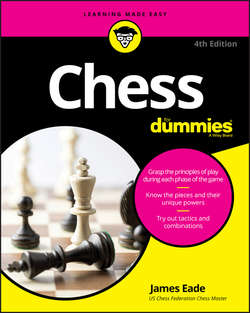Читать книгу Chess For Dummies - Eade James - Страница 8
На сайте Литреса книга снята с продажи.
Part 1
Laying the Groundwork for Champion Chess
Chapter 2
Getting to Know the Pieces and Their Powers
ОглавлениеIN THIS CHAPTER
Speeding along with the rook
Seeing the bishop outside church
Kissing the queen’s hand and bowing before the king
Mounting the knight
Giving the pawn the time of day
After years of teaching chess to elementary school children, I think I’ve found the easiest way to introduce the pieces. So in this chapter I use the same method. I start with the rook because its simple up, down, and side-to-side movement is easy to grasp. Then I move on to the bishop because it, too, moves in straight lines and boldly goes where the rook can’t. Kids seem to pick up these ideas right away. And what’s good for kids is certainly good for older students of the game, right?
After you understand the moves of the rook and the bishop, figuring out how the queen moves is a breeze. The queen simply has the combined powers of the rook and bishop. And the king follows his queen. He moves just like her, except only one square at a time. I leave the knight and the pawn for the end because they’re the trickiest to explain.
Keep in mind that chess is a science when you consider the pieces in isolation from one another, but it approaches an art when you combine the pieces in various ways. All pieces like to have company, but they’re fickle; for example, sometimes a queen and a knight are happy together, and sometimes they aren’t. No easy rules explain this relationship. The chess genius seems to know how to make the pieces work together seamlessly, but everyone else has to muddle along by trial and error. In Chapter 3, I consider the elements of chess from the scientific and artistic viewpoints – in isolation from one another and in combinations.
